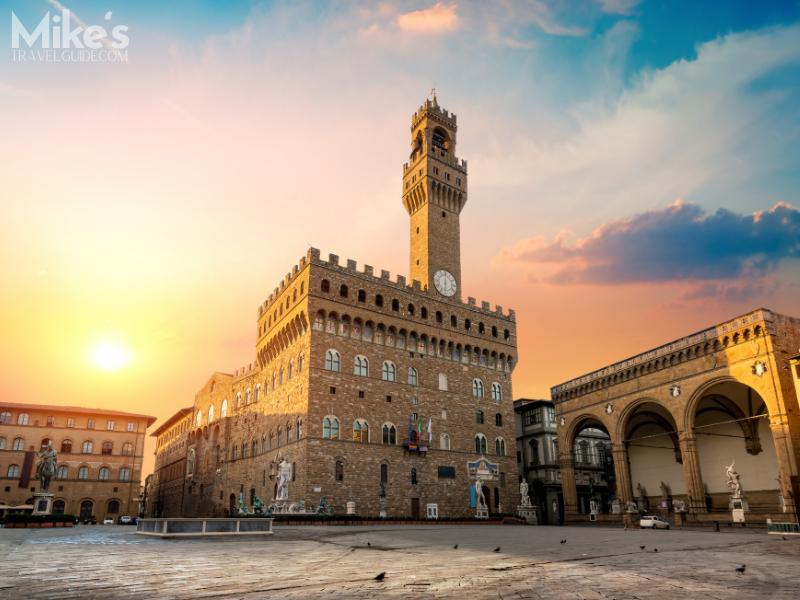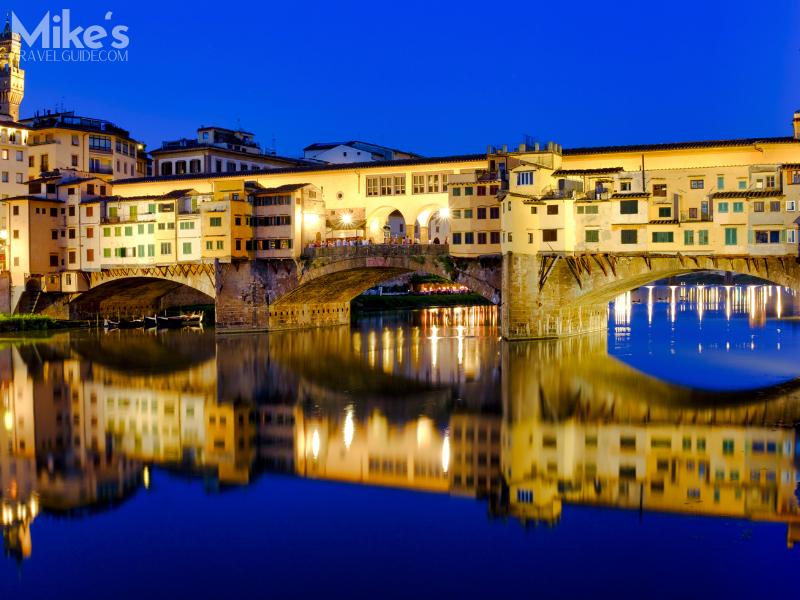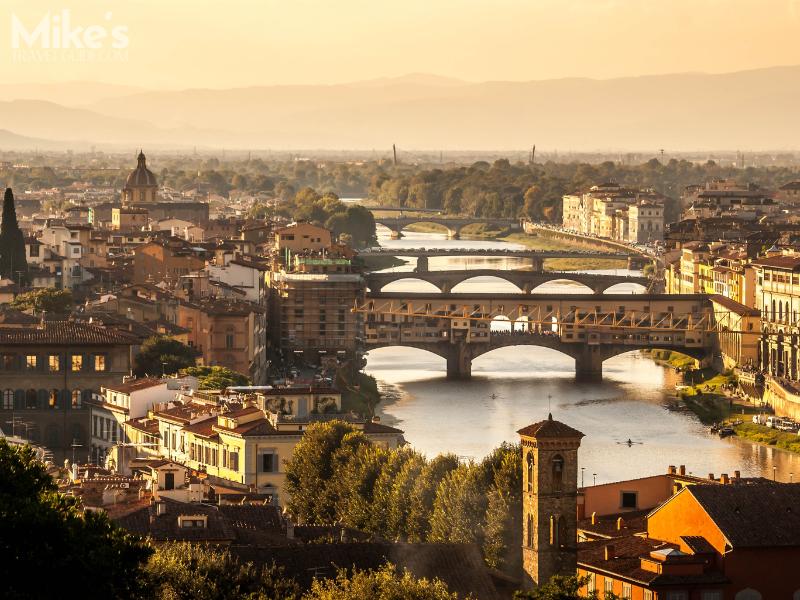Florence, the capital of Tuscany, is a city that will captivate you with its art, architecture, and history. Founded by the Romans in 59 BC, this city has been at the heart of the Italian Renaissance, giving birth to some of the world’s most iconic artists and thinkers. As a traveler, you’ll find yourself immersed in a world of beauty and culture at every turn.
Palazzo Vecchio: The Heart of Florentine Government

Your journey through Florence should begin at the Palazzo Vecchio, also known as the Palazzo della Signoria. This 14th-century palace has been the center of Florentine government for centuries and continues to serve as the City Hall today. As you approach the entrance, you’ll be greeted by a replica of Michelangelo’s David, placed here in 1910. The original statue, which stood at this spot from 1504 to 1873, now resides in the Galleria dell’Accademia.
Inside the Palazzo Vecchio, you’ll find an impressive collection of artwork that showcases the wealth and power of the Medici family, who once ruled the city. Take your time exploring the palace’s many rooms and corridors, each filled with masterpieces from the Renaissance era.
Ponte Vecchio: A Bridge Through Time

Next, make your way to the Ponte Vecchio, the Old Bridge that spans the Arno River. This iconic structure connects the northern part of the city with the Oltrarno neighborhood to the south. As you stroll across the bridge, you’ll find yourself flanked by merchant stalls offering a variety of goods, from jewelry to leather products. The Ponte Vecchio has been a hub of commerce since the 13th century, and it’s easy to imagine the bustling activity that has taken place here over the centuries.
Santa Maria Novella: A Basilica of Art
No visit to Florence would be complete without a stop at Santa Maria Novella, one of the city’s oldest and most beautiful basilicas. Now one of Florence’s Civic Museums, Santa Maria Novella houses a stunning collection of religious art, including frescoes by masters such as Masaccio and Ghirlandaio. Take a moment to admire the basilica’s intricate façade, which features a blend of Gothic and Renaissance elements.
Museo Casa di Dante: Honoring the Divine Poet
For literature lovers, the Museo Casa di Dante is a must-see. This museum, located in the house where the great poet Dante Alighieri once lived, pays homage to the author of the ‘Divine Comedy’. As you explore the museum’s exhibits, you’ll gain a deeper appreciation for Dante’s life and work, as well as his lasting impact on Italian culture.
Il Duomo: A Marvel of Architecture
No discussion of Florence would be complete without mentioning Il Duomo, the city’s spectacular cathedral. Topped by the iconic dome designed by Brunelleschi, the Duomo is a testament to the ingenuity and artistry of the Renaissance. Be sure to climb to the top of the dome for breathtaking views of the city and the surrounding Tuscan countryside.
Battistero di San Giovanni: Where the Renaissance Was Baptized
Just steps from the Duomo, you’ll find the Battistero di San Giovanni, or the Baptistery of Saint John. This octagonal building, with its intricate mosaics and bronze doors, is one of the oldest structures in Florence. Many of the city’s most famous residents, including Dante and members of the Medici family, were baptized here.
Galleria degli Uffizi: A Treasure Trove of Art
For art lovers, the Galleria degli Uffizi is a paradise. One of the most renowned art museums in the world, the Uffizi houses an unparalleled collection of Renaissance masterpieces. From Botticelli’s ‘Birth of Venus’ to Titian’s ‘Venus of Urbino’, the gallery’s halls are filled with works that will take your breath away. Be sure to book your tickets in advance, as the Uffizi is one of Florence’s most popular attractions.
Galleria dell’Accademia: Home of David
No trip to Florence would be complete without seeing Michelangelo’s David, housed in the Galleria dell’Accademia. This stunning sculpture, carved from a single block of marble, is a testament to Michelangelo’s genius and has become a symbol of the Renaissance. Along With David, the Accademia features a collection of other notable works, including Michelangelo’s unfinished ‘Prisoners’ series.
Palazzo Pitti: A Palace of Art
Across the Arno River, in the Oltrarno neighborhood, you’ll find the Palazzo Pitti. This immense palace, former residence of the Grand Dukes of Tuscany, now serves as an art gallery. The palace’s many rooms are filled with works by masters such as Raphael, Titian, and Rubens, as well as a collection of luxurious furnishings and decorative arts.
UNESCO World Heritage Site

The entire historic center of Florence has been designated a UNESCO World Heritage Site, a testament to the city’s incredible cultural and historical significance. As you explore the city’s winding streets and grand piazzas, you’ll understand why Florence has earned this distinction. From the banks of the Arno River to the top of the Duomo, every inch of Florence is steeped in beauty and history.
Travel Tips
To make the most of your visit to Florence, consider purchasing the Firenze Card. This pass offers free admission to numerous sites in and around the city, as well as free public transportation. Valid for 72 hours, the card costs €50 and can be purchased at select museums, tourist office locations, and online through the official website. Keep in mind that you’ll need to present your purchase voucher to collect your card at specific pick-up locations, so be sure to check the website for details and a list of participating museums and monuments.
Florence and the Medici Legacy
Situated on the Arno River, Florence, or Firenze as it is known in Italian, was once the home of the powerful Medici family. Their patronage played a significant role in the birth of the Italian Renaissance. Artists commissioned by the Medicis include Botticelli, Leonardo da Vinci, Donatello, Michelangelo, Raphael, and Rubens, whose works can be seen throughout the city.
Exploring Florence

Florence’s historic center is a UNESCO World Heritage Site, and it’s worth spending at least two full days exploring its many attractions. From its bustling squares to its quiet, art-filled churches, every corner of Florence tells a story.
Travel Tip: Consider the Firenze Card for free admission to numerous sites and free public transportation. Valid for 72 hours, the card costs €50 and can be purchased at select museums, tourist offices, and online via the official website. Present your purchase voucher at specific pick-up locations to collect your card. Check the website for details and a list of museums and monuments included with the Firenze Card.
Final Words
Florence, the birthplace of the Renaissance, is a city that will capture your heart and imagination. With its incredible art, architecture, and history, this Tuscan gem offers something for every traveler. Whether you’re marveling at the works of Michelangelo, strolling across the Ponte Vecchio, or savoring a gelato in a sun-drenched piazza, you’ll find yourself falling in love with Florence at every turn. So pack your bags, grab your Firenze Card, and prepare to be enchanted by the magic of this unforgettable city.
